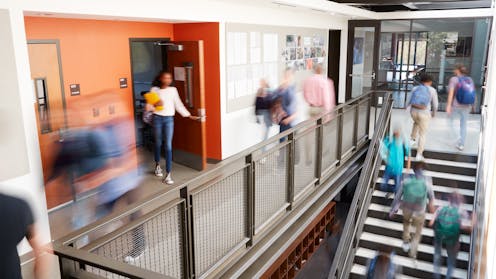The Supreme Court’s ruling on gender raises serious questions for schools
The UK Supreme Court has ruled that when the Equality Act refers to “sex” it means biological sex, not gender identity.
The Equality and Human Rights Commission has released an interim update on the implications of the UK Supreme Court judgement, which covers public spaces such as toilets.
Schools in England and Wales must already provide single sex toilets for children aged over eight, and single sex changing rooms for children over 11. Schools in Scotland must provide separate toilet facilities for all pupils. The Equality and Human Rights Commission guidance states that schools must not permit trans girls to use the girls’ facilities, or trans boys to use the boys’.
The ruling has caused worry for schools. Some teachers are concerned about the impact of potential changes for their pupils, including LGBTQ+ young people, whom they are in charge of safeguarding.
Get your news from actual experts, straight to your inbox. Sign up to our daily newsletter to receive all The Conversation UK’s latest coverage of news and research, from politics and business to the arts and sciences.
LGBTQ+ charities have pointed out that organisations enforcing toilet use on the basis of biological sex may cause disproportionate harm to trans people, threatening their dignity and rights. For instance, it may lead to the policing of bathrooms on the basis of perceived sex differences and profiling, so that those that do not “look” female or male enough can be targeted.
The Supreme Court ruling itself notes that enforcing section 29 of the Equality Act must represent “a proportionate means of achieving a legitimate aim”. Organisations must also, therefore, bear in mind they should not implement policies that can harm trans students.
Forcing transgender youth to use facilities that don’t align with their gender identity can have harmful consequences, leading to increased isolation and shame and not wanting to attend school.
In addition, separate facilities only for trans youth may also cause stigma and lead to discrimination. Young trans people may feel that their gender identity is more visible in daily school life, and this may lead to them feeling more unsafe at school.
The government is expected to publish revised guidance on how schools can support trans pupils in light of the ruling later this year. In the meantime, it is important to remember that schools have a duty of care to safeguard all pupils.
And this isn’t just about bathrooms. The Supreme Court’s ruling may have left trans and gender diverse young people (those who don’t identify as male or female), already an extremely vulnerable group, feeling more at risk. Research has pointed to schools as a place where trans and gender-diverse young people face significant discrimination from both school staff and their peers.
A systematic review of research – a study which assesses the findings of a range of scholarly research studies on a particular topic – has estimated that the proportion of adolescents who identify as trans or gender diverse is between 2.5% and 8.4%. The lowest end of that estimate would translate to 27 trans or gender diverse pupils in an average-sized English secondary school. The research also suggests that this proportion is increasing.
The importance of relationships and sex education
A key way schools can support trans and gender diverse young people is through the provision of relationships and sex education that addresses LGBTQ+ identities. This should be part of a whole school approach to safeguarding. It is necessary for the wellbeing and safety of all pupils, regardless of sexuality or gender.
A UCL Institute of Education guide to good practice that I contributed to sets out key principles to ensure high quality relationships and sex education. This includes taking into account the needs and views of all pupils, including trans and gender diverse pupils.
Comprehensive, inclusive relationships and sex education benefits all pupils.
LightField Studios/Shutterstock
Schools should consider how disability, race, culture, age and religion or belief intersect with gender and sexuality. They should be inclusive. This means acknowledging which groups have privilege, and how unequal societal and institutional structures and power relations shape society and schools.
Schools’ approach should ensure that young people have access to accurate information, health services, advice and knowledge, and encourage positive attitudes towards sexuality and body image while also tackling taboos and shame driven by inequalities. And relationships and sex education should be contemporary, relevant, and flexible.
It should incorporate the experiences of all young people, including trans and gender diverse pupils, in order to be responsive to changing school populations. Finally, it should be research and evidence driven. This means drawing upon up to date, peer-reviewed academic research evidence, rather than political bias.
The School of Sexuality Education charity has also offered further strategies for schools to be inclusive and supportive. These include challenging gender stereotypes and transphobic bullying in schools, upholding confidentiality whenever possible, and making sure to share relevant resources, including support services within the school and with parents.
Overall, high quality relationships and sex education lessons that cover issues of LGBTQ+ sexual health and rights will enable schools to be inclusive environments that prioritise the safety, respect and dignity of all pupils.
Still, the Supreme Court’s ruling has put schools and teachers in a difficult position. Schools urgently need the government to deliver its guidance on this issue – in a way that addresses schools’ very real concerns about the welfare of their trans pupils.
Jessica Ringrose receives funding from Arts and Humanities Research Council.


